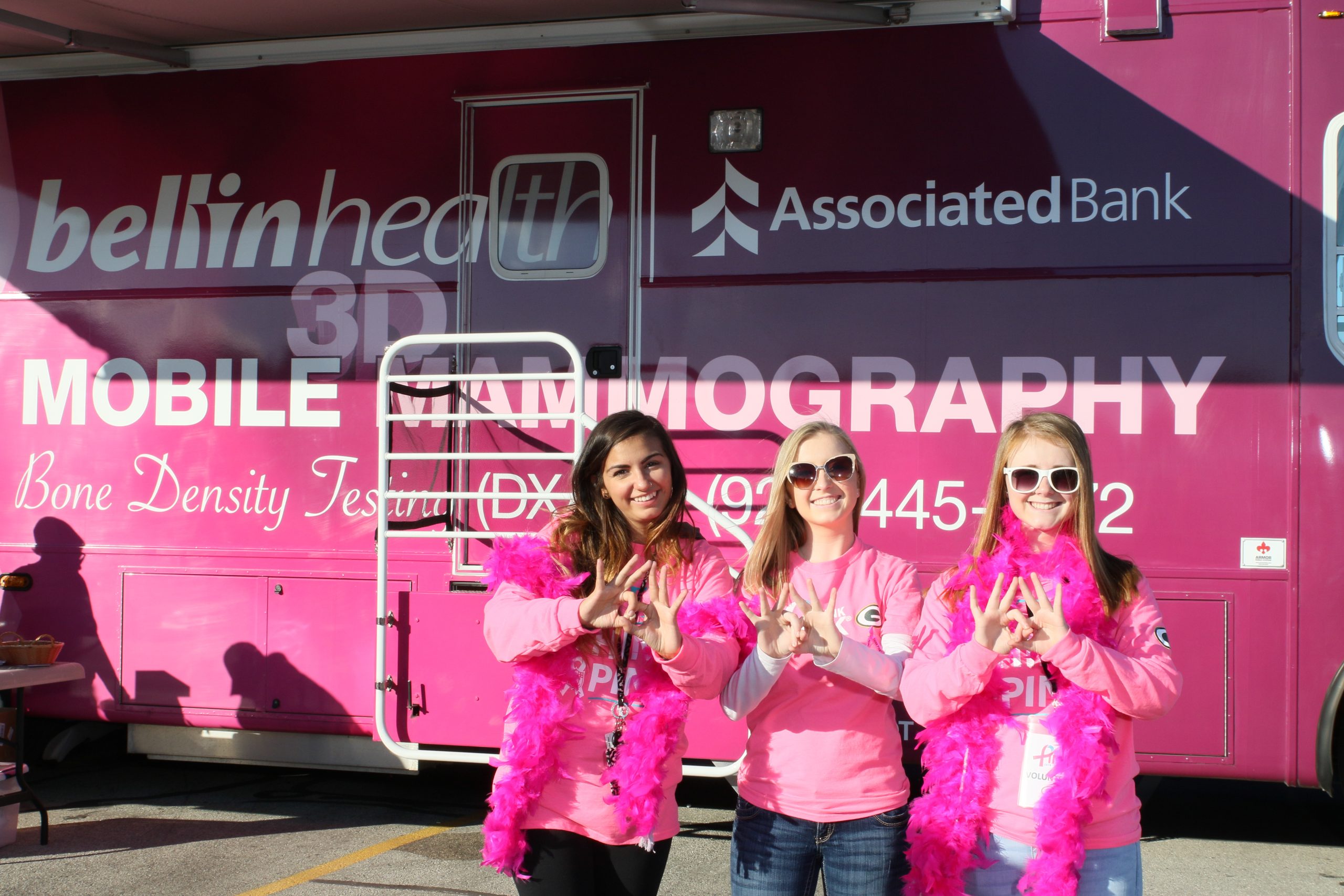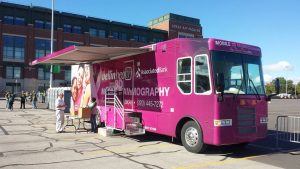October rolls around and suddenly you notice pink everywhere… pink signs, pink ribbons, and pink clothing as far as the eye can see. That’s because, as I’m sure you’re much aware, October is breast cancer awareness month. Organizations and people worldwide unite to promote breast health and cancer awareness while raising funds to donate. For Bellin Health in Wisconsin, breast health is not just an October activity. Through cutting-edge 3D mammography, a mobile unit to service rural areas, and a passionate staff, Bellin is bringing breast health to an entire new level.
Jolene Bartlett, a radiology technologist, excitedly explained the Bellin Mobile Mammography program that started in December of 2014. Bellin has equipped a coach bus with digital Hologic 2-D and more recently 3-D imaging technology. The mobile unit is staffed by two registered mammography technologists and one bone density technician each. The new 3-D imaging allows radiologists to see through the breast tissue better, revealing more invasive cancers than 2-D images alone may not have shown. This is allowing patients to treat their cancers earlier than ever before. Prior to the mobile unit, only Algoma and Oconto F
alls—two rural clinics in Northeast W isconsin—were performing screening mammography. Since the mobile unit’s launch, that number has increased to seven rural clinics in the area, bringing this cutting-edge technology right to the patients’ own neighborhoods. In 2015, a total of 2,900 patients were screened. So far in 2016, the number of screenings has almost reached last year’s total and is expected to exceed that number.
 On the bright pink bus, patients are able to receive screening mammography. In the hospital, they would get their screening done, have a radiologist check the images, receive the results, and be set up with any necessary follow-ups via a breast health nurse. Because of the large file size of the 3-D images, transmission to the radiologist takes a bit longer so patients who get a mammogram on the bus receive their results the next business day. Bellin has been watching the development of 3-D mammography over the last 15 years and it was finally FDA approved in 2011. Bellin decided to implement it on the mobile unit as one of the first places in the area with this cutting-edge technology.
On the bright pink bus, patients are able to receive screening mammography. In the hospital, they would get their screening done, have a radiologist check the images, receive the results, and be set up with any necessary follow-ups via a breast health nurse. Because of the large file size of the 3-D images, transmission to the radiologist takes a bit longer so patients who get a mammogram on the bus receive their results the next business day. Bellin has been watching the development of 3-D mammography over the last 15 years and it was finally FDA approved in 2011. Bellin decided to implement it on the mobile unit as one of the first places in the area with this cutting-edge technology.
Jolene wanted to dispel the myth that 3-D mammography exposes patients to large amounts of radiation when compared to traditional 2-D mammography. When first being developed, 3-D mammography included both a 2-D exposure as well as a 3-D, doubling the typical radiation exposure (which is still under the allowable exposure). Now, the 3-D imaging technology looks at 1 mm slices of breast tissue at a time and is then able to synthetically create the 2-D image from the 3-D image. Double exposure is no longer required when getting a 3-D mammogram.
Implementing a mobile mammography unit like this one is not without its hiccups. Driving a coach bus requires CDL licensed operators. Additionally, there is a major difference between the sizes of the 2-D and 3-D images, increasing transmission time for 3-D mammography. This means that if patients need diagnostic mammograms, they have to travel to Bellin Hospital which may be as far as 60 miles away. As other local clinics adopt the newer technology, the 3-D mammography and image reading software will be more widely available, lessening the burden on patients. Until then, a car ride to town might be the only option for the 3-D diagnostics. Despite these challenges, nearly 3,000 patients a year are receiving screening mammography that detects cancers up to fifteen months earlier than 2-D mammography would reveal. The Bellin Mobile Mammography unit is reaching people that have not had mammograms in years, and some who have never had one.
Breast health is important, and not just in the month of October. The pink that we all recognize is proudly displayed on the exterior of the bus, making it hard to miss. Because of the passion that Jolene and her colleagues have, rural patients are being serviced in preventative care that can ultimately save their lives. Moving forward, we as a medical field should consider adopting mobile units that go to rural areas for services beyond mammography and bone density screenings. With developing telemedicine, the options we may be able to offer are endless.


